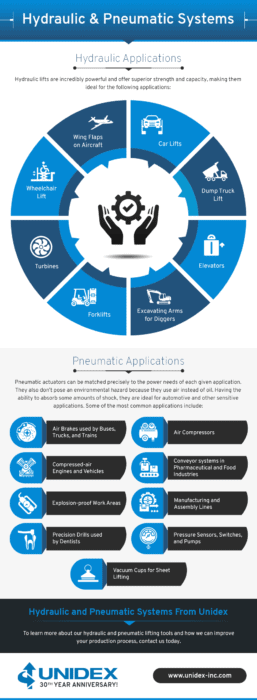Pneumatic and hydraulic systems use fluid power to increase pressure and move mechanical parts in machinery. While pneumatic systems use compressible air or pure gas to achieve their function, hydraulic systems use compressible liquid, such as oil. Commonly seen in lifts and other handling equipment, pneumatic and hydraulic systems offer many advantages, making them ideal for a wide range of applications.
Hydraulic Vs. Pneumatic Lifts
Lifts refer to equipment used to raise or lower objects, such as people, cargo, heavy machinery, and more. In order to produce the upward pushing force necessary to move objects, lifts utilize a range of actuating mechanisms and components. The two most common actuator types include hydraulic and pneumatic.
Hydraulic Lifts
Hydraulic lifts utilize a lifting mechanism that compresses a liquid, such as oil, to increase pressure within the cylinder, generating the linear motion that is needed to raise and lower the platform and object. Capable of producing more than 25x the force of pneumatic lifting systems, hydraulic lifts can tolerate very heavy loads. Hydraulic lifting mechanisms can also hold torque and force at a constant level without continuous fluid flow, unlike their pneumatic counterparts.
One primary concern of hydraulic lifts is their environmental impact. Since these mechanisms use hydraulic fluid, they can be damaging to the environment in the event of a leak. Additionally, hydraulic lifts tend to take up more space due to having several components and parts, meaning they are best for applications where space isn’t a primary concern.
Pneumatic Lifts
The lifting mechanism within a pneumatic lift utilizes a hollow cylinder and piston. Through the use of an external motor or pump, the piston moves within the cylinder to increase air pressure, allowing the cylinder to move and create enough linear force to extend the lift components.
One primary advantage of pneumatic lifts is their versatility. Since most pneumatic lifts don’t require electricity, they are suited for a variety of applications, including those exposed to extreme temperatures and other environmental conditions. Pneumatic systems are also very accurate, capable of generating extreme force, and less expensive than hydraulic systems.
However, pneumatic lifts must maintain operating pressure during use, making them less efficient and more costly to run than other lift types. Also, pneumatic actuators are normally sized for specific applications, limiting them to the needs of that application’s specifications and requirements.
Applications for Hydraulic and Pneumatic Systems
While both hydraulic and pneumatic systems are powerful lifting tools, they are each suited to their own applications.
Hydraulic Applications
Hydraulic lifts are incredibly powerful and offer superior strength and capacity, making them ideal for the following applications:
- Car Lifts
- Dump Truck Lift
- Elevators
- Excavating arms for diggers
- Forklifts
- Turbines
- Wheelchair Lift
- Wing Flaps on Aircraft
Pneumatic Applications
Pneumatic actuators can be matched precisely to the power needs of each given application. They also don’t pose an environmental hazard because they use air instead of oil. Having the ability to absorb some amounts of shock, they are ideal for automotive and other sensitive applications. Some of the most common applications include:
- Air brakes used by buses, trucks, and trains
- Air compressors
- Compressed-air engines and vehicles
- Conveyor systems in the pharmaceutical and food industries
- Explosion-proof work areas
- Manufacturing and assembly lines
- Precision drills used by dentists
- Pressure sensors, switches, and pumps
- Vacuum cups for sheet lifting
Hydraulic and Pneumatic Systems From Unidex
Hydraulic and pneumatic systems work differently to lift objects, and they each offer their own unique advantages. At Unidex, we specialize in providing standard and custom material handling manipulators, lifts, and work positioners to meet the needs of any application. To learn more about our hydraulic and pneumatic lifting tools and how we can improve your production process, contact us today.


